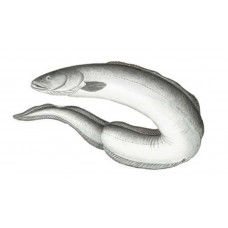Latin name
Conger oceanicus
Other names
Conger, dog eel, sea eel, silver eel; French: congre d’Amerique; Spanish: congrin americana.
Identification
Conger are distinguished from moray eels by having pectoral fins (morays have none) and by the dark or black margin on their dorsal and anal fins. Conger eels are scaleless, and their dorsal fins originate over the tips of the pectorals. They grow much larger than American eels, with which they are sometimes confused in inshore environs.
Distribution
The American conger occurs in the western Atlantic from Cape Cod, Massachusetts, to Florida and in the northern Gulf of Mexico.
Habitat
This species ranges widely from shallow inshore waters, occasionally in brackish environs, to waters hundreds of feet deep. The eels usually suspend over rocky or broken bottoms or may linger around wrecks, piers, pilings, and jetties.
Size
The American conger can grow to 71⁄2 feet and 87 pounds, most commonly found weighing 10 to 20 pounds and 5 feet long. Females grow larger than males.
Life history and Behavior
The life history of this fish is similar to that of the American eel, although the latter enter freshwater. Sexual maturity occurs between 5 and 15 years of age, and spawning congers migrate seaward, spawning in the summer in water that may be more than 1,000 feet deep.
Food and feeding habits
The diet of the nocturnal-feeding conger eel includes fish, shrimp, small shellfish, and crustaceans.
Reproduction
No information
| Classification | |
| Phylum | Chordata |
| Class | Actinopterygii |
| Squad | Anguilliformes |
| Family | Congridae |
| Genus | Conger |
| Species | C.oceanicus |
| Features | |
| Conservation status | Least Concern |
| Habitat | bottom |
| Life span, years | No information |
| Maximum body weight, kg | 40 |
| Maximum length, cm | 200 |
| Sailing speed, m/s | No information |
| Threat to people | Edible |
| Way of eating | predator |
Eel, American Conger
Tags: Eel, American Conger




